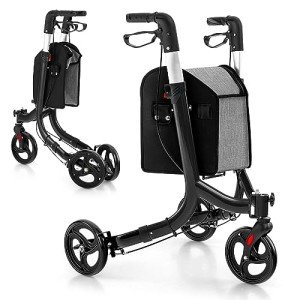walking-frame8492
walking-frame8492
Why People Don’t Care About Rollator Walker
The Comprehensive Guide to Rollator Walkers
As the population ages, the need for mobility aids like rollator walkers has actually surged. These walkers supply stability, assistance, and liberty of motion for individuals dealing with mobility issues, be they temporary or persistent. Comprehending the kinds of rollator walkers available, their benefits, features, and how to select the ideal one can considerably boost the quality of life for both the user and their caretakers.

What is a Rollator Walker?
A rollator walker is a Mobility Aid (http://101.33.255.60) developed to assist people keep their self-reliance while walking. It includes a frame with 4 wheels, hand brakes, and a seat, making it ideal for users needing additional support without the complete constraints of standard walkers.

Secret Features of Rollator Walkers
Rollator walkers come equipped with different features created to enhance user experience. Here are some of the most typical functions:
- Four-Wheel Design: The most distinguishable function is its 4 wheels, which allow for smoother transitions over various surfaces.
- Cushioned Seat: Many rollators come with an integrated seat, offering a resting point for users who may tire easily.
- Hand Brakes: Most designs have hand brakes that enable users to secure the walker in location when sitting or browsing uneven surfaces.
- Storage Options: Many rollators consist of a basket or storage pouch for individual products, such as water bottles or little bags.
- Adjustable Height: Users can customize the height of the deals with for optimal convenience and posture.
Benefits of Using a Rollator Walker
Rollator walkers offer numerous benefits. They can significantly improve mobility and safety for users. Here are some crucial benefits:
- Enhanced Stability: With four wheels and a sturdy frame, rollators supply remarkable stability compared to standard walkers.
- Hassle-free Seating: The integrated seat allows users to rest whenever required, promoting longer trips without fatigue.
- Increased Confidence: The added assistance can assist users feel more safe during walks, which can lead to longer distances took a trip.
- Enhanced Posture: With adjustable heights, users can maintain a more natural posture while walking, which can lower discomfort.
- Independence: Rollators make it possible for many people to regain or preserve self-reliance in their day-to-day activities.
Types of Rollator Walkers
Rollator walkers can be found in different designs and variations to satisfy individual needs. Here are a few common types:
| Type | Description |
|---|---|
| Requirement Rollator | Basic four-wheeled model created for indoor and outdoor use. |
| Junior Rollator | A smaller sized version tailored for shorter people or children. |
| Durable Rollator | Developed to accommodate larger body weights and offer additional stability. |
| Three-Wheel Rollator | Compact design perfect for navigating tight spaces. |
| Rollator with Seat | Features an integrated seat for resting throughout use. |
| Rollator with Storage | Includes detachable baskets or pouches for simple transport of personal products. |
Choosing the Right Rollator Walker
Selecting the best rollator walker includes considering user requirements, preferences, and physical requirements. Here are some elements to think about:
- User Height and Weight: Ensure the walker can support the individual’s weight and can be changed to their height.
- Terrain: Consider where the walker will mostly be used. Removable wheels can assist move efficiently over rough terrains.
- Storage Needs: Determine if extra storage area is necessary for the user’s everyday needs.
- Portability: If regular transportation is necessary, lightweight designs or those that fold for easy storage must be preferred.
- Spending plan: Prices can vary significantly; make sure the selected walker supplies value without compromising quality.
Upkeep of Rollator Walkers
Correct upkeep can boost the lifespan of a rollator walker. Here are some suggestions for keeping it in excellent condition:
- Regular Check-ups: Periodically examine brakes and wheels for wear and tear.
- Clean the Walker: Use a mild cleaning agent and cloth to clean down surface areas and remove dirt.
- Look For Loose Parts: Tighten any screws or bolts that may end up being loose with routine use.
- Change Parts as Needed: Wheels, hand grips, and brakes can use out and might require replacement for maximum performance.
Frequently Asked Questions About Rollator Walkers
Q1: What is the typical weight limitation for a rollator walker?A: Most basic rollator walkers support weights between 250 to 300 pounds, while durable designs can accommodate up to 500 pounds. Q2: Can rollator walkers be utilized outdoors?A: Yes, many rollatorsare developed for outdoor use. Those with
bigger wheels and robust frames are especially matched for uneven surface areas. Q3: Do rollator walkers feature warranties?A: Many makers provide service warranties varying from 1
to 5 years on the frame and parts, ensuring resilience and user fulfillment. Q4: How do I appropriately change a rollator walker?A: Adjust the manages to a height that enables the user to stand upright with
elbows a little bent when holding the handles. Q5: Can
I use a rollator walker for rehabilitation?A: Yes, rollators are often used in rehab settings to improve walking confidence and mobility
after injuries or surgeries. Rollator walkers
are important tools that supply boosted mobility and independence for lots of people. By understanding the types, benefits, and proper usage of rollator
walkers, users can make informed choices that best suit their lifestyle and needs. Whether recovering from an injury or managing a long-lasting condition, a rollator walker can make a considerable distinction in the quality of life, allowing individuals to regain their flexibility and self-confidence while moving about the world.



 Total Users : 3632
Total Users : 3632